MXA RACE TEST: THE REAL TEST OF THE 2023 HUSQVARNA TC250 TWO-STROKE

Q: FIRST AND FOREMOST, IS THE 2023 HUSQVARNA TC250 BETTER THAN THE 2022 MODEL?
A: The answer to this question isn’t a simple “yes” or “no.” The 2023 model is better, but it has some limitations.
Q: WHAT’S NEW ON THE 2023 HUSQVARNA TC250?
A: The new Husqvarna comes with most of the updates that the 2023 Husqvarna four-strokes got. That includes the updated chromoly steel frame, rearward-rotated engine, lower countershaft sprocket, aluminum/carbon composite subframe, stronger swingarm, smaller rear axle, advance WP shock, and exotic new white, grey and yellow plastics. And, it goes without saying but we’re gonna say it anyway, an all-new, fuel-injected, electronic-power-valve, electric-start, two-stroke engine. Here are the highlights of the new TC250 powerplant.
(1) Fuel injection. Gone is the traditional Mikuni TMX carburetor with its main jet, pilot jet, needle and air screw. It is replaced by a 39mm Keihin throttle body with dual injectors.
(2) ECU. To help control its advanced features, the TC250 has a brand-new ECU. The full name of it is “VIT ESCO Continental M4C,” and it determines the optimal air/fuel mixture, power-valve timing and new rev limiter.
(3) TPS. A throttle position sensor was added to work with the ECU, the power valve and the fuel-injection system.
(4) Power valve. For years, the KTM power valve has been spring-loaded, and you could use stiffer or softer springs to adjust the roll-on power character of the engine. Now, the power valve uses an electric motor that opens and closes based on throttle position and engine rpm.
(5) Map switch. The ECU mapping also uses the power valve to create multiple map options for two different engine characteristics; however, it doesn’t feature traction control or quick shift like the 2023 four-strokes.
(6) Electric start. The new 2023 Husqvarna TC250 has an E-start. Although the TC250 wasn’t hard to start before, we aren’t complaining about the electric starter.
Q: HOW DOES THE FUEL-INJECTED ENGINE DIFFER FROM THE CARBURETED ENGINE?
A: The TC250 is very friendly as soon as you roll on the gas compared to the traditional carbureted KTM and Husqvarna two-strokes, which have more of a “hit.” The new fuel-injection system creates a perfect air/fuel ratio for controllable power that really makes the TC250 easier to ride. Test riders realized instantly that it took less effort to ride the EFI two-stroke. With a carbureted two-stroke engine, it requires skill to maintain the rpm and throttle in the sweet spot of the powerband—often with the aid of the clutch to keep it on the pipe.

Q: HOW DOES THE HUSQVARNA TC250 RUN ON THE TRACK?
A: The new Husqvarna TC250 runs great! It’s similar to a four-stroke in that the power comes on quicker without any hesitation. Throughout the rpm range, the Husqvarna TC250 is crisp; however, when you’re booking it down a rough straightaway and your rear wheel catches air, you’ll notice the rev limiter kicks in. With carburetors allowing a fixed amount of fuel and air into the combustion chamber, we never had to worry about a rev limiter because the carb was self-regulated. When over-revved, a two-stroke engine eventually runs out of fuel, but it will still try to make power. With fuel-injected two-stroke engines, the ECU has to have built-in safety parameters to ensure the engine doesn’t push beyond its capabilities. When the rear wheel was in the dirt, we never felt the rev limiter kick in. But when we caught air or pulled in the clutch, it was very easy to hit it.
Q: HOW ARE THE MAPS ON THE NEW HUSQVARNA TC250?
A: Believe it or not, the KTM and Husqvarna 250cc two-strokes have come stock with two map options for many years, but not every model had a map switch. Instead, KTM had a small wire connector underneath the fuel tank that you could unplug to access the mellower map two, while the Husqvarna TC250 came with a map switch that allowed you to switch maps on the handlebars; however, the maps weren’t very different from each other, so they didn’t get a lot of attention in our tests. Most KTM/Husky 250 two-stroke owners didn’t even know their bike had two maps.
The new TC250 has the same electronic map switch as the Husqvarna four-stroke model, minus the quick shift and traction control buttons. The White Map (aka Map 1) only allows the electric power valve to open up 80 percent of its arc, which creates a mellower power delivery. The Green Map (aka Map 2) allows the power valve to open all the way, giving you all the exhaust port height the TC250 has. Our test riders felt that the White Map was easier to manage in the tighter sections and good for inexperienced riders, but they would never choose to race in it. The Green Map was much, much faster and far more adrenaline-inducing.
In comparison to the maps on the new 2023 KTM 300SX, both the White and Green Maps were very similar in power output; however, this is not the case with the Husqvarna TC250 maps. Somehow, the Green Map is several horsepower stronger than the White Map. We aren’t sure if this is on purpose or a mistake, but it is wild.
Q: CAN YOU ADJUST THE MAPPING ON THE 2023 HUSQVARNA TC250?
A: Up until KTM and Husky introduced the 2021-1/2 Factory Edition models, riders had the ability to remap their stock KTM ECUs. What does that mean? It means you could take the ECU off your stock KTM four-stroke, hand it to Twisted Development (or another tuner) and have them remap (or re-flash) the bike’s brain (electronic control unit) to make the bike run exactly how you wanted it to.
Remapping your stock ECU never offered as much room for customization as an aftermarket Vortex ECU, but remapping the stock ECU could unlock a little extra horsepower in areas where the manufacturer had been cautious. It was especially helpful for riders who modified their engines, added an aftermarket exhaust, increased the compression or used race gas, because remapping set new limits and parameters for the engine to work with; however, when KTM and Husky came up with the handlebar-mounted Bluetooth connectivity unit on the 2021-1/2 Factory Editions, they changed the stock ECU configuration and put a halt to aftermarket tuners like Twisted Development modifying the parameters by locking the stock ECU. Why? KTM/Husky/GasGas felt that allowing their ECUs to be hopped up in terms of ignition advance and fuel flow could result in blown engines. Not only did they lock the stock ECUs for this reason, they are loath to warranty any engine that suffered a failure while running an aftermarket Vortex or GET ignition.
Up until recently, aftermarket ECU manufacturers like Vortex and GET have been the only options for remapping a 2021-1/2 and newer model KTM/Husqvarna/GasGas four-strokes, but, at this moment, Vortex and GET don’t make ECUs for the 2023 KTM/Husky two-strokes. Recently, WMR Motorsports, a longstanding KTM dealership in Florida (which owns Nihilo Concepts), cracked the code on the Austrian ECUs, gaining access to all the four-stroke ECU codes and even the fuel-injected two-stroke models. We haven’t tested their remapped ECUs yet, but we hope to try them out on our TC250 and other fuel-injected Austrian two-strokes soon.
Q: WHY DOESN’T VORTEX MAKE AN ECU FOR THE NEW 2023 KTM/HUSKY TWO-STROKES?
A: Vortex has a solid business model that works well in the off-road motorcycle realm. Luckily for them, most major dirt bike manufacturers use ECUs that are made by Keihin. Yamaha is the only manufacturer that makes its own ECU. The primary Vortex ECU is based on the Keihin ECU, and it’s just programmed differently for Honda, Kawasaki, Suzuki, KTM, Husky or GasGas bikes. Vortex makes a separate ECU for Yamaha. The problem for the Austrian two-strokes is that the fuel-injected KTM/Husky two-stroke ECUs are made by Continental, and Vortex doesn’t have compatible aftermarket upgrades yet. Why not? It would cost Vortex a pretty penny to develop the hardware and software needed to replace and upgrade the Continental’s two-stroke setup, and there is no guarantee that the KTM Group won’t switch to another system in the near future. Fuel-injected two-strokes are brand new with rapidly improving technology. That makes investing in all-new components and software a risky investment for aftermarket ECU manufacturers. 
Electric starting is brand new. It might be overkill since two-strokes are easy to start, but we aren’t complaining.Q: HOW DOES THE KTM TC250 RUN ON THE DYNO?
A: The 2023 Husqvarna TC250 dyno results tell two different stories. As mentioned already, the two maps are completely different. We’ll start with the more powerful of the two maps—the Green Map. The major feature of the Green Map is that it opens up the power valve 100 percent. Numbers-wise, at 7500 rpm, the engine hits 46 horsepower and then dips slightly before regaining speed and climbing to an impressive 52.12 horsepower at 8600 rpm. Peak torque is 32.40 pound-feet.
The White Map is the mellow setting. It only allows the power valve to open 80 percent. In the White Map, the TC250 engine is smoother off the bottom and rolls through the powerband with a very linear curve. Comparing the 2023 fuel-injected TC250 engine to last year’s carbureted engine, the 2023 Husqvarna TC250 engine produces an impressive 3 horsepower more. To gain even more power on the ’23 TC250, we ran an FMF Racing Factory Fatty pipe and Titanium Powercore 2.1 silencer. Combined, the pipe and silencer made the bike run even cleaner on the bottom end and allowed it to rev further on top.
Q: HOW IS THE LOWERED WP SUSPENSION?
A: The new chassis that comes on the 2023 KTM/Husky big bike models was created to be more stable with less squat under acceleration. The engine is rotated backward to lower the countershaft sprocket 3mm, which changes chain torque for less squatting. The new chassis also has a taller seat height in the pits and a taller ride height on the track. On the KTM, it feels much taller, but the Husqvarna doesn’t feel as drastically tall because it sits an inch lower than the KTM. Husqvarna began shortening its fork legs and revising its rising-rate shock linkage in 2021. The lower platform has been a hit with the MXA wrecking crew, Vet riders and anyone under 5-foot-9.
On the track, the 2023 Husqvarna TC250 suspension settings are very soft, benefiting our Novice and Vet test riders who aren’t going as fast. Comparing the TC250 suspension settings to our KTM 300SX, the Husqvarna is much plusher. The Husky two-stroke is also much softer than the Husqvarna four-stroke models.
All our test riders appreciated the lower chassis on tighter and more technical tracks because of its ability to carve corners, but our intermediate and Pro riders wanted more hold up. To make the stock settings work, our Pro riders dropped the forks to flush in the triple clamps and set the high-speed adjuster on the shock to one turn out to get the bike to sit higher in its stroke.
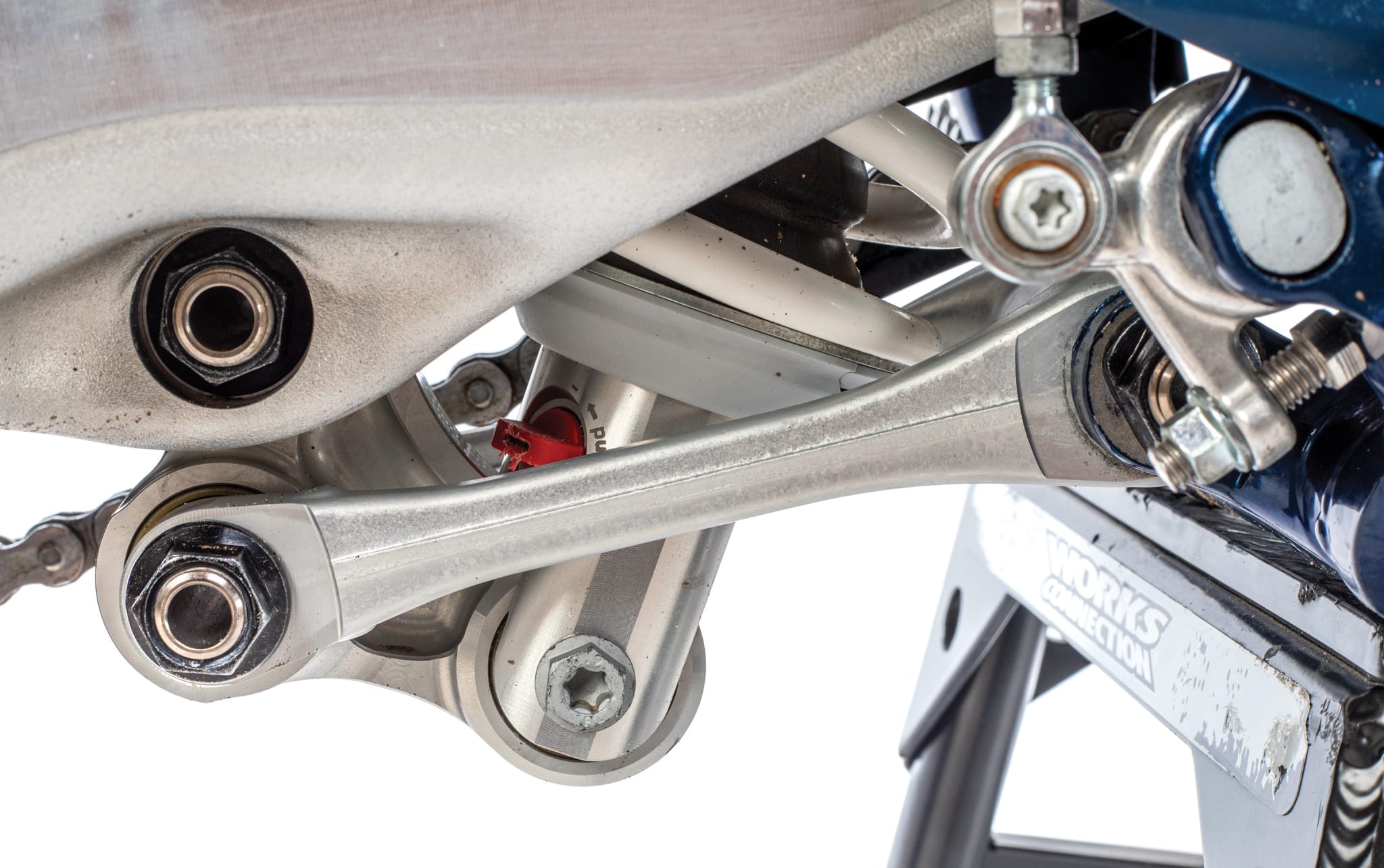
Q: HOW DOES THE TC250 HANDLE ON THE TRACK?
A: We must assume the softer suspension settings helped with the break-in process of the stiffer 2023 chromoly frame, because the TC250 was much more comfortable to ride in the first couple hours than the FC450 was. The lowered suspension worked well with the new, fuel-injected TC250 engine. Since the power rolls on easier and smoother down low, the 2023 bike naturally carves through corners better than last year’s bike.
The fuel-injected engine is faster than the carbureted 2022 model, but our favorite aspect isn’t the extra 3 horses, it’s the smoother roll-on power that gets out of turns with less clutch work. The smoother roll-on power means you can ride lower in the rpm range, which helps the bike’s handling. Dirt bikes can get bound up tight when they’re revved to the moon, which causes them to deflect off bumps rather than absorb them. Because the fuel-injected engine makes the bike easier to ride, you use the clutch less and feel the benefits of a smoother ride. Yes, the 2023 frame is stiffer than the 2022 model, but it’s not as noticeable on the new two-strokes as it is on the new four-strokes.
Q: WHAT DID WE HATE?
A: The hate list:
(1) Spokes. Husqvarna and KTM claimed to have made their spokes stronger for 2023, but we have the same exact problems. Keep an eye on them.
(2) ECU. We hate that the stock ECU is locked on the Austrian bikes.
(3) Radiator cap. The plastic radiator cap is so hard to open and close that Nihilo Concepts makes an aftermarket tool to help get the cap off. That’s not a good sign.
(4) Bodywork. We hate that you have to remove the rear fender to take the side number panels off.
(5) Wheel spacers. Unlike the last 20 years of KTMs and the last 10 years of Husqvarnas, you cannot run your older spare rear wheels on the 2023 model without changing the seals and spacer tube.
(6) Aesthetics. We prefer the previous all-white Husqvarna plastics. The grey doesn’t stand out, and the yellow rear fender confuses people into thinking it’s a Suzuki.
(7) Price. With all its upgrades, the Husky TC250 jumped up from $8599 to $9049.
This is the map switch. The top button only opens the power valve by 80%. The lower button opens the power valve 100%. We raced with the 100% button on.Q: WHAT DID WE LIKE?
A: The like list:
(1) Fuel injection. The throttle-body-injected EFI system is much different from the off-road model’s transfer-port-injected (TPI) system. It’s smooth, predictable and produces great power.
(2) Suspension. The WP XACT suspension is vastly improved over the last three years. It suits an amazingly wide range of riders. The Husky settings, even though valved the same as the KTM 250SX forks, seem more tailored to Novice and Vet riders, though.
(3) Brakes. We love Brembo brakes.
(4) Power valve. The new electric power valve also contributes to the more usable power.
(5) Maps. We’re thankful to have two map options on the TC250. Even though the power was so much less in the White Map, it was still smooth and fun to use on tracks with lots of corners.
(6) Electric start. Why did KTM and Husky add electric starting to their two-stroke models. That’s simple. Since fuel-injected bikes need a battery, the Austrians could add electric starting without adding any additional weight. Most MXA test riders claimed it felt weird to press a button to start a two-stroke, but since they also race electric-start four-strokes, they got over it. One caveat! Keep the throttle off until you press the starter button, then give it a little fuel and she’ll fire right up.
(7) FMF. The TC250 ran well with the FMF Factory Fatty pipe and Powercore 2.1 silencer. Read the full test on page 60.
Q: WHAT DID WE REALLY THINK?
A: The 2023 Husqvarna TC250 is super fun to ride. It’s also crisper and cleaner revving than the ultra-exciting KTM 300SX model. The fact that you can’t re-jet the new EFI two-strokes (because there aren’t any jets) and you can’t unlock the ECU to change the fuel settings means that any time we were faced what we felt was a lean situation, we had to switch to a 50/50 mix of pump and race gas. Racing these bikes is fun, but the Husqvarna TC250 and its KTM brothers are first-year models, and engine builders are still scared to touch these engines as they are limited in what they can do.
If you’re a serious racer, you might want to wait a year for the Austrians to work out their fuel-injected two-stroke kinks; however, if you have no qualms about racing a stock two-stroke that makes 52 horsepower, you will be more than happy with the smoother and easier-to-ride powerband. You might even grow to love the electric starter. When compared to the KTM 250SX, the Husky has softer suspension settings and a closed-off airbox, which slightly lessens power at the crack of the throttle.
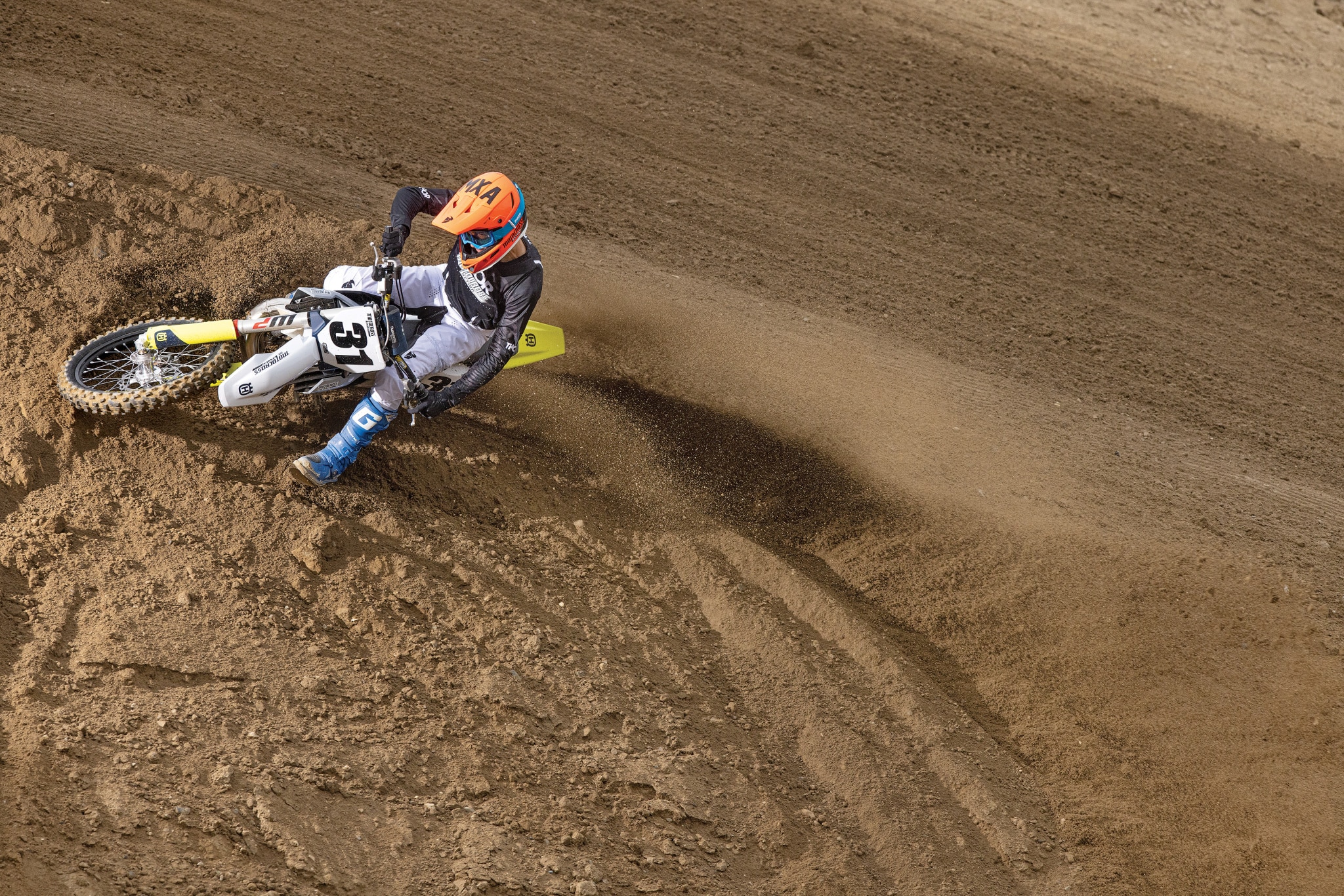
MXA’S 2023 HUSQVARNA TC250 AIR FORK SETTINGS
The stock WP XACT air forks are soft on the 2023 Husqvarna TC250. As always, don’t start to adjust your air pressure or clicker settings until you set the shock’s sag for your weight. Plus, make sure to bleed the built-up air pressure out of the little Torx head screws on top of the fork caps. For hardcore racing, we recommend this fork setup for the 2023 Husqvarna TC250.
Air pressure: 10.5 bar/152 psi (Novice), 10.8 bar/157 psi (Intermediate), 11.0 bar/159 psi (Pro).
Compression: 8 clicks out (for Intermediates and Pros), 12 clicks out (for slower and lighter riders).
Rebound: 10 clicks out (for Intermediate and Pro), 18 clicks out (for slower or lighter riders).
Fork height: Flush (for Intermediates and Pros), 2nd line (for slower or lighter riders).
Notes: As always, use a zip-tie on the fork leg to measure how far down the forks are compressing during a regular moto. The goal is to land the zip-tie at 1-1/2 inches from the bottom. This is the sweet spot. Use the air pressure (which acts as your spring rate) to help you find that sweet spot. Then, use the compression and rebound clickers to slow or speed up the rate at which your forks compress. Also, on a hot day, your forks will gain pressure over time. Check the pressure periodically throughout the day.
MXA’S 2023 HUSQVARNA TC250 SHOCK SETTINGS
The WP XACT rear shock is easy to feel comfortable on. For hardcore racing, we recommend this shock setup for the 2023 Husqvarna TC250:
Spring rate: 45 N/mm.
Hi-compression: 1 turn out (for Intermediates and Pros), 1-1/2 turns out (for slower or lighter riders).
Lo-compression: 8 clicks out (for Intermediates and Pros), 12 clicks out (for slower or lighter riders).
Rebound: 10 clicks out (for Intermediates and Pros), 16 clicks out (for slower or lighter riders).
Race sag: 105mm.
Notes: The race sag should always be the first thing you set when dialing in your new suspension. Load or unload the spring until you can sit on it and have 105mm of sag. From there, check the static sag, which is the natural sag your shock has when the bike is flat on the ground without a rider. If it’s below 30, your spring rate is too soft for you. If it’s above 40, your spring rate is too stiff for you.


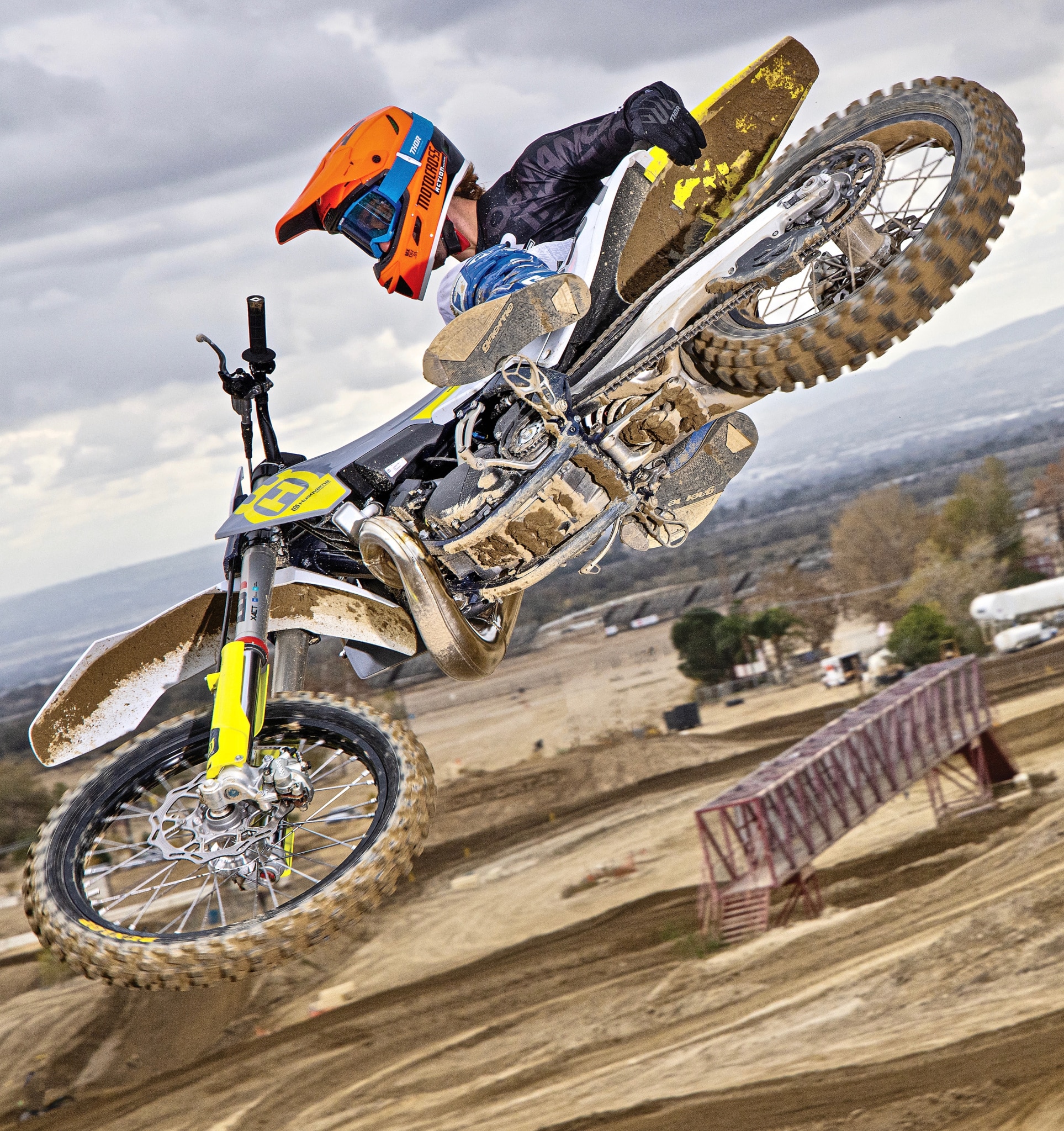
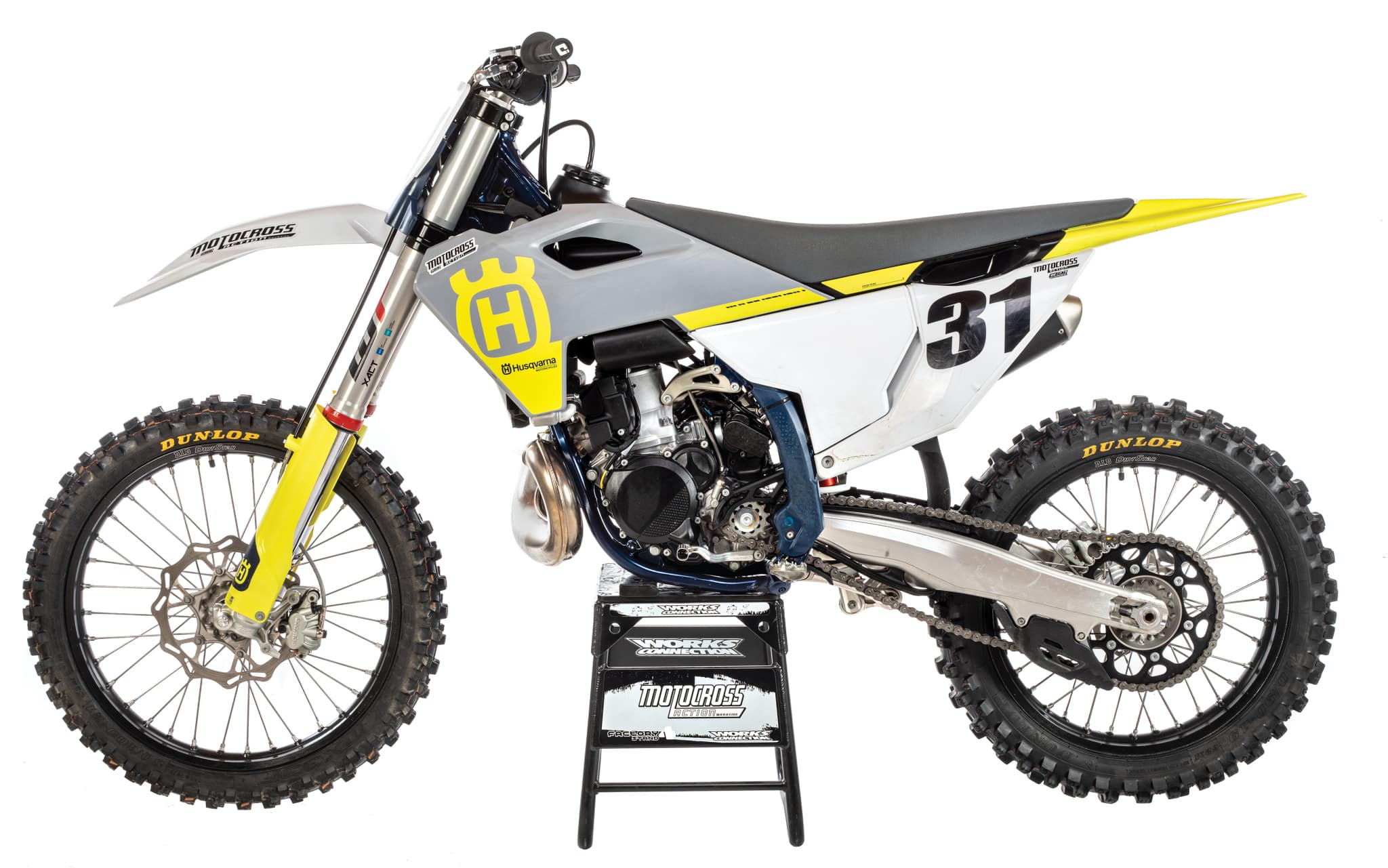

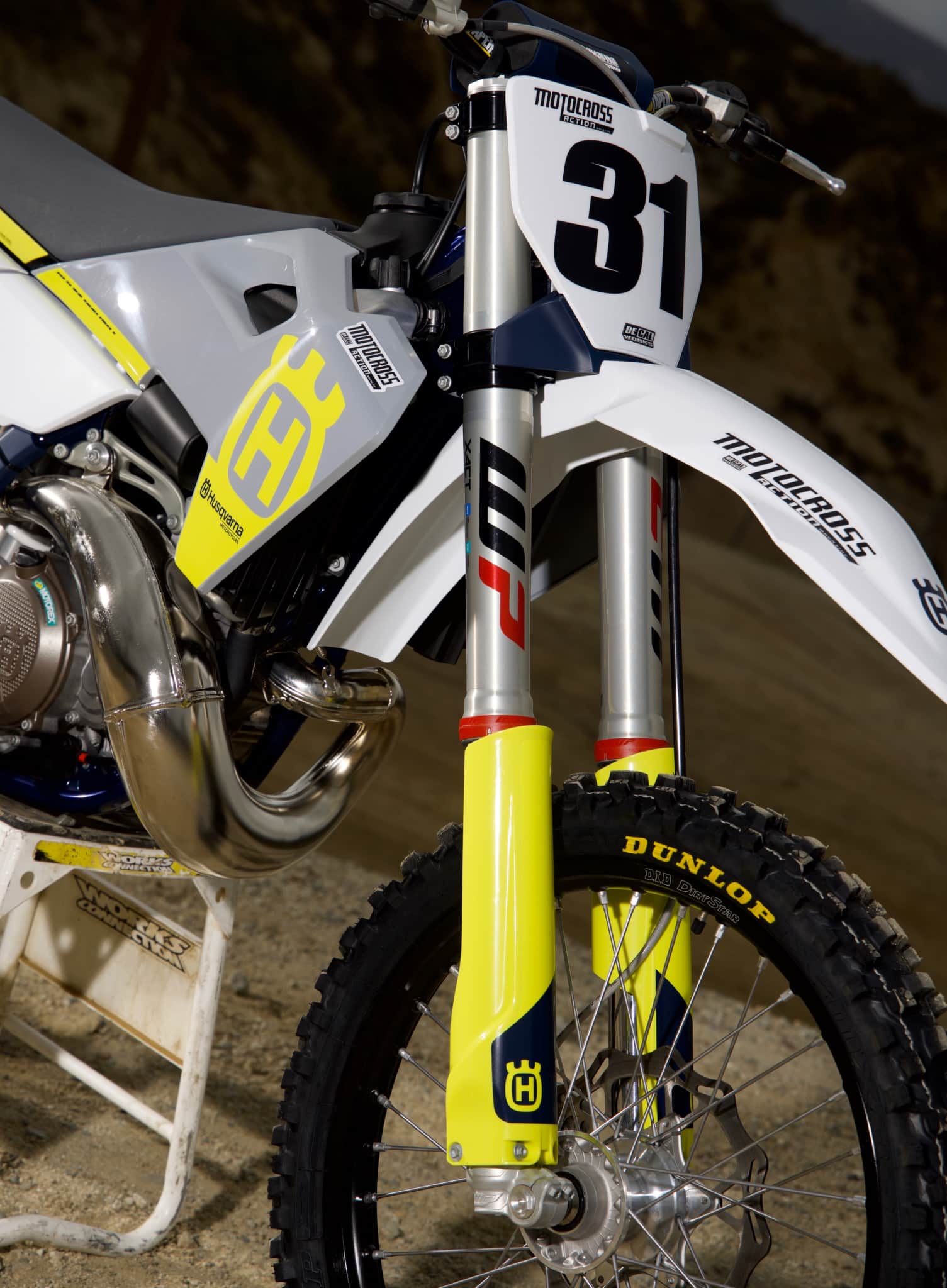



Comments are closed.